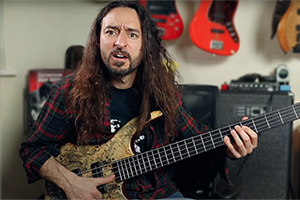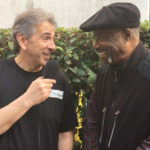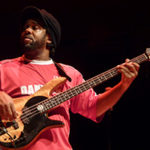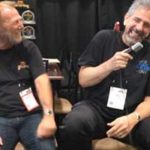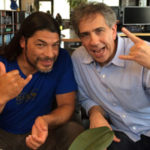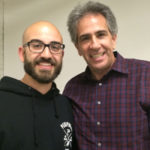Italian fusion bassist describes his groundbreaking color-coded scale system
Exclusive interview with FBPO’s Jon Liebman
May 31, 2021
Italian-born bassist Alex Lofoco made a powerful debut in 2017, with the release of his first solo album, Beyond. The recording is an exuberant mix of jazz, rock, Latin, funk and heavy metal, featuring a head-turning roster of contributors that includes Jordan Rudess, Marco Minnemann, Eric Marienthal, and Jesús Molina. Beyond that, Lofoco is a sought-after educator who’s taught clinics and masterclasses at places like the Musicians Institute in Los Angeles, the British and Irish Modern Music Institute (BIMM) in Brighton, England, and ICMP Music College in London. He’s also the creator of the Scale Colour System, a unique approach to learning scales that combines aspects of music theory with the mechanics of stringed instruments.
FBPO: How did you become a bass player?
AL: Well, like many other bass players, by accident. I’ve been exposed to music since I was quite young, about 7 years old. My dad pushed me into piano, because he loved piano music. So, because he was too lazy, possibly, to start learning himself, he just pushed his kid. When I was 15, got into Iron Maiden and started listening to their albums. I didn’t actually know what the bass was until I reached the age of 17. Some classmates at the high school wanted to put a band together and they asked me, “Why don’t you play bass?” I said, “What’s the bass?” “That thing that does dum, dum, dum.” Listening to Iron Maiden and that sort of heavy music, I didn’t hear anything that made dum, dum, dum because Steve Harris has got that distinctive clicky sound.
FBPO: I have a hunch you found your way to the bass through the drums. Is that right?
AL: For me, the bass and drums was one thing. I found out afterwards that the really exciting aspect of the drums of Iron Maiden was actually the bass on top of it. Once I realized, I said, “Is that the bass that comes in after the drums, before the guitars, in that song?” They said, “Yeah, that’s the bass.” “Oh, fuck. I want to play bass!” Then after a couple of months, I started buying some scores to learn to play bass, some self-taught methods, even before purchasing the instrument, because I wasn’t a good student. I put some money together and bought the first Yamaha RBX 260 and I fell in love with it. I brought the bass everywhere.
FBPO: How old were you when you left Rome and went to London?
AL: I was 27, almost 28. I was born in September ’81. I knew that Iron Maiden came from London and the Queen was riding along, but I didn’t even know where the city was on the map, to be honest.
FBPO: What made you decide to leave Rome and go to London?
AL: There was this school I attended, which was called back then, Tech Music School. Now it’s called BIMM.
FBPO: Do you know Nolly? He went to BIMM.
AL: Oh, yes. He’s from the north, so he went to the Birmingham one.
FBPO: You were already pretty well established in Italy before you left for England, weren’t you?
AL: I knew how to play, definitely. I had a lot of experience under my belt, but it was an excuse to change the scenery and see what’s happening. So for me, it was actually a good experience to relearn the same things I knew, but in a different language because I could speak English. I never actually learned bass academically. I was gigging a lot in Italy, in Rome especially, and I was touring the country. Before I left, I was working in a guitar store in Rome, one of the historical guitar shops. Bandiera, it’s called, which means flag.
FBPO: What kind of gigs were you doing? What kind of music were you playing?
AL: Well, apart from some Iron Maiden covers, some pop, and even some jazz. I don’t know why people were calling me to do jazz standards, swing nights in a four-piece: piano, bass, drums, and sax.
FBPO: What about in the London music scene? What kind of stuff have you been doing there?
AL: I started gigging when I first moved in, in 2008. I had the official excuse to study at the uni, so that was the main excuse to move to London. But then after a year, things weren’t really happening because I never learned how to contact people and get gigs. In Rome, I got phone calls to play here, play there, do this, do that. In a new country, in a different town where there are at least 100,000 people that want to do exactly the same thing you want to do, I was completely lost in a way. I found a couple of studios that are probably closed down now, and I did some cover gigs. Here there is a big industry of function bands. Function bands are like a birthday or wedding party bands.
FBPO: Right. Casuals, club dates…
AL: Yeah. They call them function bands. It was a concept that I never actually learned in Italy, so I did a bit of that. But I wasn’t very happy because I thought, “Well, yeah, you get some money, some good money in your pocket by the weekend, but then how are you going to step up?” Because I don’t think that Elton John will pass by the pub and say, “Oh, I like you. Come and play with me.”
FBPO: Miles Davis got a lot of his people by doing exactly that! At places like Ronnie Scott’s…
AL: Different times. Probably the times make a lot of difference. But then in 2009, a year after I arrived, I started actually giving clinics or masterclasses and demonstrations because I’d developed over the years a big passion for (Jaco) Pastorius, after Steve Harris, and then Rocco Prestia of Tower of Power. I really enjoyed the interview you did with Rocco a couple of years ago.
FBPO: That was at a Summer NAMM show a few years back. Yeah, Rocco was great.
AL: Then Victor Wooten. I cracked most of Victor Wooten’s licks and way of playing. Even my teachers were interested because they couldn’t do it. I was really focused. I spent a lot of time doing those funny techniques, double thumbing, strumming and all these funny combinations. So I thought, well, I like teaching. I liked demonstrating because when I was working at the music shop in Rome, that was my job. I started doing more clinics and demonstrations before actually doing professional gigs and touring. I don’t know how to fit into the musicals, West End musicals. Everyone wants to get a gig there because they’re well paid. They’re secure for at least a year or two or whatever. But I was a newcomer. I needed to find something else because no gigs were coming.
FBPO: What is the Scale Colour System all about? How did you come up with that?
AL: It is an idea I came up with to show how simple the geometry of the notes are on the guitar and bass. Basically, I’ve been trained to teach all ages, from 7 to 50. Some people, especially adults, were always getting confused in mapping the scales. They didn’t really know or remember what fingering to use and how to move. I said, “Look, you see a C major scale. You do it in vertical shape. On the first string, you do a block of one tone, which, let’s say it’s red. The second bit is half step, whole step, one, two, four. Let’s call it blue. The other one is completely different altogether. Let’s call it yellow. One, three, four.” So you got three slices. I was thinking about a bread loaf and the slices. You can put them all next to each other and that won’t change its nature. Basically, you can play them vertically when you play a scale vertically. You use this fingering and it’s the same fingering you use across the neck. You know it, but applying the colors on it allows you to see how the pattern repeats itself.
FBPO: Great idea.
AL: Thanks. I kept it for ten years before doing a book. I was doing this sort of a prototype on my iPad, on the train on the way to the lesson. But the first time I used it, this concept to a student who knew nothing about this system or this idea or notes or anything, it took him one and-a-half hours to play all the major scale modes in any key, all over the neck. I was laughing because I thought, “Fuck, it took me a year to figure it out, even just to move across the neck, and this guy gets it in one hour-and-a-half here? Must be good!” I thought maybe it’s too good to be true. I thought there were some holes maybe, so I kept it in the drawer. Then after ten years of making sure it actually works, I put it down.
FBPO: Have you applied this concept to the upright bass too? A lot of the fingerings are different.
AL: No. I play it on the guitar, so there is a guitar version of it. It can actually be applied to trumpets too because they have one whole step or one half step and another third, so I can color the three different intervals. It’s just a way to memorize it because, with scales, the less you think about them, the better.
FBPO: Are you familiar with Jerry Jemmott’s Color Sound project? I think he’s going for a different end result where he cites Pythagoras. He says this concept goes way back.
AL: No, actually. I should ask him. I know his concept of The Bass in You method he did, but not about this color thing.
FBPO: Tell me about your gear.
AL: My gear? It’s changing every day! Yesterday I got the new modified overdrive pedal. It’s a T-Rex for guitar. I have a 5-string Laurus bass, the Italian handmade. I’m a big fan of EMG pickups, so I try to place them wherever I can. I have a new bass. It’s called Cortex and it’s got a very funky top. It’s a bolt-on, 24 frets. I’m using Eich amps, which I find very transparent with a bit of a bite, which is something I like for this kind of a modern attitude. I’m using this Dogal strings, handmade strings in Venice, Italy. They’re very big in classical string instruments, cellos, violins. What I like a lot is that [they] are soft, and I can bend them.
FBPO: What advice do you have for somebody who wants to learn bass?
AL: Make a lot of noise and experiment. Discover. Music is a discovery, so before buying any book, including mine, spend a good few months in disassembling the bass, playing by ear, trying to figure it out, because that’s the way everyone learns, including myself. Once you have an idea, even if it’s wrong, at least it’s your idea. Then when you learn from somebody else, you have a solid starting point. If you don’t know anything and you go straight to the lessons, you are basically gambling on the ability of the teacher to give you a good mindset. You need to be open-minded to music, having fun, not forgetting why you’re playing, and trying to get the best out of the discovery process. You know your shit because nobody told you. You figured it out and then you compare it.
FBPO: The first thing you said in response to my question was, “Make a lot of noise.” What exactly do you mean by that?
AL: That you don’t need to be afraid to express yourself, even in the noise. Drummers, they make noise, but they organize it in a way that sounds musical. But it’s still noise. It’s percussion. You need to channel the chaos to make it sound musical. You want to try things out. I don’t expect somebody to pick up a violin and a bow and make a Bach suite. You start by making noise. That’s how everyone starts. If you give the bass to a 50-year-old or a 3-year-old, they make the same sound, which is noise. So you start making noise and then you narrow it down.
FBPO: What would you be if you weren’t a bass player?
AL: The other passion I had before going back to the bass was archeology and history. I tried to study medieval anthropology back in Rome. I was very much into Middle Ages. The 12th Century was my favorite time. I like the weapons and the armors and making them by myself. I really like the anthropological aspect of history, why something happened, as opposed to just what happened.
See Jon’s blog, with key takeaways from this interview here.
Alex’s solo album, Beyond, is available here:

